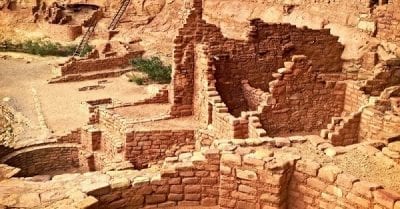 In May, archaeologists made strides in proving the existence of King David. Reportedly, many experts have doubted the biblical account of David, noting that there is no evidence suggesting that there was even civilization in the time David is said to have ruled. According to Breaking Israel News, Professor Avraham Faust, who led the archaeological dig, said that scientists really only started doubting David’s existence in the last 25 years. He said, “Until 25 years ago no one doubted that King David was a historical figure.” He continued, “In the last 25 years or so, however, David’s historicity, and especially the size of his kingdom, are hotly debated.”
In May, archaeologists made strides in proving the existence of King David. Reportedly, many experts have doubted the biblical account of David, noting that there is no evidence suggesting that there was even civilization in the time David is said to have ruled. According to Breaking Israel News, Professor Avraham Faust, who led the archaeological dig, said that scientists really only started doubting David’s existence in the last 25 years. He said, “Until 25 years ago no one doubted that King David was a historical figure.” He continued, “In the last 25 years or so, however, David’s historicity, and especially the size of his kingdom, are hotly debated.”
All of that changed, however, when archaeologists discovered a large ancient city in Israel.1
Archaeologists, aided by burrowing mole rats, discovered a large building in the valley below the hills of Hebron attributed to the kingdom of Biblical King David. The discovery is a milestone in the ongoing debate over the veracity of Biblical King David as a historical figure with most archaeologists now looking to the Bible as having a factual basis.
“Until 25 years ago no one doubted that King David was a historical figure,” Professor Avraham Faust, director of the archaeological dig, told Breaking Israel News. “In the last 25 years or so, however, David’s historicity, and especially the size of his kingdom, are hotly debated“.
“The new discovery at Tel ‘Eton, located in the Judean Shephelah to the east of the Hebron hills, seems to suggest that the highland kingdom controlled larger areas than some scholars believe”, Faust added.
The dig, led by Professor Faust of Bar-Ilan University, is at Tel Eton, in the valley near the Hebron hills. The city that once stood at the site has been identified by scholars as Eglon, a city which, according to the Bible, fought against the Israelites as part of the five Amorite kings coalition and was later listed as part of the tribe of Judah.
This was the portion of the tribe of the Judites by their clans…Lachish, Bozkath, Eglon. Joshua 15:20,39
The discovery has become part of an ongoing dispute among archaeologists about whether King David actually existed as a real historical figure or whether he was just a mythological figure existing only in the pages of the Bible.. The finds from Tel ‘Eton, recently published by Faust and Yair Sapir in the journal Radiocarbon, led the authors to claim that the city was once part of David’s kingdom. The structure was dated to the 10th century – the time in which King David was supposed to have ruled according to the Bible – on the basis of radiocarbon dates of samples from the floor make-up and from the foundation deposit. After describing the building and the reasons that led them to date it to the 10th century BCE, Faust and Sapir wrote:
“This has bearings on the date in which social complexity evolved in Judah, on the debate regarding the historicity of the kingdom of David and Solomon.”
Dr. Faust explained how they came to this remarkable conclusion.
“We, of course, did not find any artifacts that said ‘King David’ or King Solomon’ but we discovered at the site signs of a social transformation the region underwent, including the construction of a large edifice in a plan known to archaeologists as ‘the four-room house’ which is common in Israel but is rare to non-existent elsewhere. This seems to indicate that the inspiration or cause for the transformations are to be sought in the highland. The association with David is not based on any archaeological evidence but on circumstantial grounds only. Since the source of the change seems to be in the highlands, and since it took place at the time when David was supposed to have existed, the link is plausible,” Professor Faust told Breaking Israel News. “Moreover, the changes are consistent with larger regional changes, all connected with the highlands, and all taking place at a time the Kingdom of David was supposed to have to spread into this region”.
“The association with the highland kingdom, as well as the time of the change, are the main discovery, and if someone thinks that there was no King David, that person should come with a different name for the highland king in whose time the region was incorporated into the highland kingdom,” Professor Faust added.
“The association with the highland kingdom, as well as the time of the change, are the main discovery, and if someone thinks that there was no King David, that person should come with a different name for the highland king in whose time the region was incorporated into the highland kingdom”.
This connection between the Bible and archaeology made by Professor Faust can be problematic, as Dr. Eilat Mazar, a prominent Israeli archaeologist, explained.
“Archaeology does not begin with a belief and the Bible and then a search for proof,” Dr. Mazar told Breaking Israel News. “We first find evidence and then try to understand the truth behind the evidence.”
For the most part, evidence of Biblical events is lacking, Dr. Mazar noted.
“Even with what is written about David, one of the more prominent figures in the Bible, there are very few events that would leave evidence we could find archaeological proof of today.”
Nonetheless, Dr. Mazar uses the Bible as a resource to guide her work. This has set her at odds with many other Israeli archaeologists who reject the validity of this technique.
Continue Reading at BREAKINGNEWSISRAEL.com



